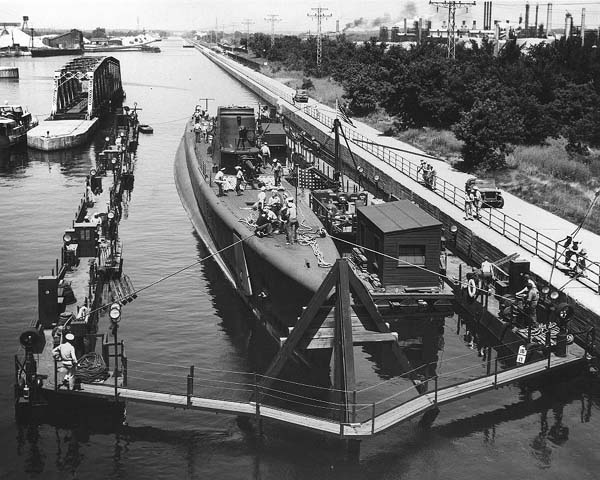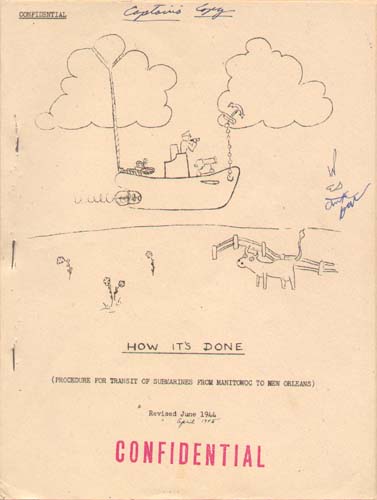HOW MANITOWOC-BUILT SUBMARINES
REACHED THE SEA
In the deciding to build submarines in Manitowoc, several obstacles
had to be considered. One of the early doubts that Navy officials had about
building submarines at Manitowoc concerned the sideways launching, required
because the river there was too narrow to permit stern-first launchings.
All previous vessels built at Manitowoc had been launched in this matter.
However, a submarine’s low stability and circular hull presented unique
problems. The design of the launching ways had to be considerably
altered in order to permit safely launching submarines.
Another obstacle was that of getting large ships to sea from
the Great Lakes. There were three main routes available for reaching the
ocean. The main route was via the Saint Lawrence river, but this was before
the construction of the Saint Lawrence Seaway. The series of locks between
Cornwall and Lachine on the Saint Lawrence River were only 270 feet long
and had only 14 feet over the sills; these dimensions restricted this part
of the route to small vessels. Another route was the Erie Canal, but the
combination of shallow depths and clearance under fixed bridges eliminated
this route.
The route via the Mississippi River to New Orleans required
entering the Chicago Sanitary Canal by way of the control lock at Lake
Michigan, then passing into the Chicago River and thence to Lockport, Illinois,
where vessels entered the Illinois River. From the Illinois River, ships
passed into the Mississippi River at Grafton, Illinois, about 38 miles
above St. Louis, and then on to New Orleans and the sea. The obstacles
on this route were the depth of the Sanitary Canal, the many bridges that
crossed it, some of which were fixed, and the controlling depth of water
at Chain of Rocks Channel in the Mississippi River about halfway between
Grafton and St. Louis, which was 9 feet. In order to overcome this obstacle,
Manitowoc Shipbuilding developed a plan to use floating drydocks to lift
the submarines out of the water and traverse safely that 9 foot-deep stretch
of the Mississippi River.
After Manitowoc boats had completed their trials on Lake Michigan,
they sailed under their own power to Navy Pier in Chicago. The boats were
then prepared for the trip through the Chicago River and the Chicago Sanitary
Canal. What follows is a typical experience for those boats making the
transit from Manitowoc to the port of New Orleans.
The boats were towed by two tugs, one on the bow, and one astern,
through Chicago to Lockport in order not to foul up the engine circulating
water systems. There were also some very tight turns and the river had
very little maneuvering room. Furthermore, while lift machinery had been
installed on nearly all the bridges that had previously been incapable
of opening, there were still some, such as the railroad bridge at Western
Avenue, for example, that couldn’t be opened at various times.
At Western Avenue it would be necessary to trim the submarine
down in the water in order to pass under this bridge, and in order to minimize
the pollution of the trimming tanks as much as possible, the boat was partially
trimmed down to about 19 ft. 6 in. draft while in the outer harbor alongside
the dock. The tugs would then pull away from the dock and head for the
Control lock that had to be passed through before entering the Chicago
River. The tow would enter the river at 6:10 a.m. This early transit of
the Loop District was, of course, planned so as to interrupt traffic in
the heart of the city of Chicago as little as possible. It was a thrilling
sight in the misty predawn to see the nine bridges in the Loop District
raise in sequence on a time schedule as the tow approached. It was also
an experience to transit this narrow cut between the tall buildings on
either side of the river. The tow would proceed and enter the Sanitary
Canal just before reaching the railroad bridge at Western Avenue. The clearance
under this bridge was extremely critical. The tow was stopped and lay-to
while calculations were made. The clearance of the bridge above water level
was obtained by reading the gauge on the bridge and then a determination
was made as to the draft of the submarine that was required to enable it
to pass under. This draft figured to about 21 ft. 6 in., so water was flooded
into the trimming tanks to obtain exactly this draft. With the boat trimmed
to this draft, the stability was very touchy, particularly fore and aft.
During this passage the personnel on board were forbidden to move in order
not to disturb the fore and aft balance of the boat, and the tugs had to
operate very carefully in order not to dip the bow of the submarine. As
the tow passed slowly under the Western Avenue bridge, there was a clearance
of about two inches with the bridge and the clearance under the keel was
about six inches! This evolution took about one-hour to accomplish.
After all the bridges over the Chicago River had been renovated
as necessary, so they could be opened, these delicate procedures did not
have to be followed for future boats. After that, the boats were able to
be quickly towed through Chicago to Lockport, thence to the drydock waiting
down river. The trip from the lock at Chicago to the drydock was a distance
of about 34 miles, and some 51 bridges had to be passed through or under.
On arrival at the trimmed-down drydock, the submarine entered the dock,
was centered on the blocks, and secured. The dock was then pumped dry,
the submarine braced, and the tug made up to the dock. Then commenced the
1,500 mile journey to New Orleans, a journey that consisted of numerous
narrow twists and turns of the rivers, many bridges, several locks, and
shallow spots (at times, the tow would have to be tied up to a tree on
the riverbank while waiting for some dangerous situation ahead to clear
up).
(Above Information Courtesy of Les Guille, Menhaden's Last Commanding
Officer, who visited the Manitowoc Maritime Museum in Manitowoc, Wisconsin,
in August of 1999)

 USS Menhaden (SS-377) in the floating drydock on the Illinois
River near Lockport, Illinois, on July 16th, 1945.
(Photo Courtesy of John Mansfield, RM2(SS), Menhaden, 1963-65)
USS Menhaden (SS-377) in the floating drydock on the Illinois
River near Lockport, Illinois, on July 16th, 1945.
(Photo Courtesy of John Mansfield, RM2(SS), Menhaden, 1963-65)
 HOW THE TRANSIT WAS DONE
HOW THE TRANSIT WAS DONE
 Front Cover of Captain David H. McClintock's Transit Procedure
Manual
TO
PROCEDURE MANUAL: PAGES 1-6
TO
PROCEDURE MANUAL: PAGES 7-12
TO
PROCEDURE MANUAL: PAGES 13-18
TO
PROCEDURE MANUAL: PAGES 19-24
TO
PROCEDURE MANUAL: PAGES 25-30
TO
PROCEDURE MANUAL: PAGES 31-36
(Manual Courtesy of David H. McClintock, Jr., son of Captain
David H. McClintock, Menhaden's First Commanding Officer)
Front Cover of Captain David H. McClintock's Transit Procedure
Manual
TO
PROCEDURE MANUAL: PAGES 1-6
TO
PROCEDURE MANUAL: PAGES 7-12
TO
PROCEDURE MANUAL: PAGES 13-18
TO
PROCEDURE MANUAL: PAGES 19-24
TO
PROCEDURE MANUAL: PAGES 25-30
TO
PROCEDURE MANUAL: PAGES 31-36
(Manual Courtesy of David H. McClintock, Jr., son of Captain
David H. McClintock, Menhaden's First Commanding Officer)


